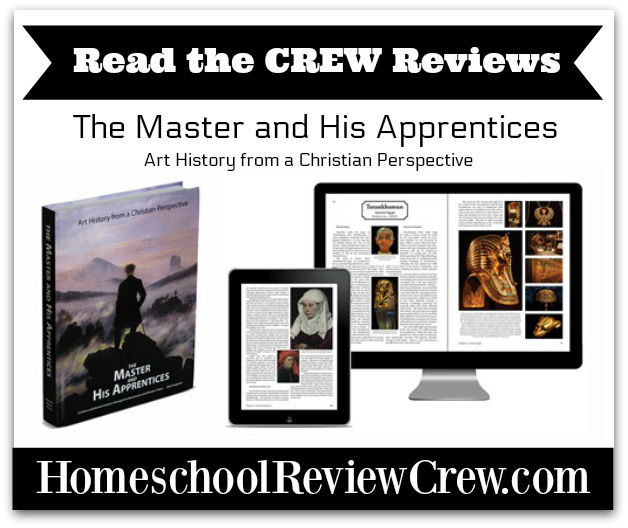 |
For purposes of our review, we received the Digital Edition of both the Textbook and the Teacher Guide which included PRINT/PHOTOCOPY RIGHTS for our household. Of course you know that I'm a "hard copy" kind of gal, so it will come as no surprise to you that I am printing the chapters as we come to them. As with most things, after I print, I 3-hole punch and add to a binder. BUT . . . just so you know going into the rest of this review, I would LOVE to have the hardcover textbook as well. It is a coffee table-sized book with over 500 full-color pictures and I can just picture us thumbing through it together for years to come.

"One of the primary advantages of studying art history is that it provides a visual timeline (on paper or in our minds) that can be used to help connect other important periods and events."
Divided into 19 chapters, The Master and His Apprentices starts at the very Beginning with Biblical Creation (chapters 1 and 2), visits Ancient Cultures (chapters 3 - 5) and Classical Antiquity (chapters 6 - 8), stops in the Middle Ages (chapters 9 - 12), explores the Renaissance (chapter 13 - 16), and ends at the Baroque Era & Beyond (chapters 17-19) all the while offering praise and glory to GOD as the original ARTIST from whom all talent comes. Although the course is designed to offer a full high school elective credit in Art History (36 weeks), there is so much information packed into its pages that you could easily use it for a high school World History credit, as well. I am aslo enjoying studying through it myself as a supplement to my personal Bible study. Reading the descriptions and explanations provided helps me to visualize GOD's Word in a new way.
Because I have printed the chapters in black and white thus far, we are making sure to utilize the digital format in order to see the rich colors throughout the text. My printed copy is useful for answering the questions found on the worksheets in the Teacher's Guide -- my daughter prefers reading from the paper copy. The Digital Teacher's Guide (116-pages) tells you exactly what needs to be done when. It offers instructions for use in a classroom setting and a home setting and has a detailed syllabus to ensure that your student stays on track. There are discussion questions, worksheets, and exams provided, as well as instructions for papers. Answers are included for the worksheets and tests. These are the things that make up the "nuts and bolts" of the course. It is SO MUCH MORE than "nuts and bolts," though.
I always find it most interesting when life lines up with our homeschooling. How about you? Does that happen very often for you? Last week was Vacation Bible School at our church and we spent the week teaching about Babylon during the time that Daniel was being held in captivity. Part of the Bible lessons taught about the use of cylinder seals and all of the kids in attendace got to see them in action. Now mind you, we didn't have a real cylinder from Ancient Near East, but we were able to make one using the reverse intaglio method. Ours was made from a foamcore tube and foam sticker pieces were added to make the reverse raised design. Everyone had the opportuinity to roll the cylinder seal to create a continuous design to mark their property. Talk about perfect timing. What I especially like is that an Art History course was the tool used to reinforce what is being taught at church.
 |
 |
 |
 |
You will definitely want to find out even more about The Master and His Apprentices and you can do that by visiting the following Social Media sites:

I was given the opportunity to review the The Master and His Apprentices: Art History from a Christian Perspective from The Master and His Apprentices as a member of the Homeschool Review Crew. Make sure that you visit the Crew Review to see what other members of the Crew thought of this fabulous Art History course, too. You can click on the picture below to jump right over there.


No comments:
Post a Comment
Thanks for stopping by and sharing your heart with me!